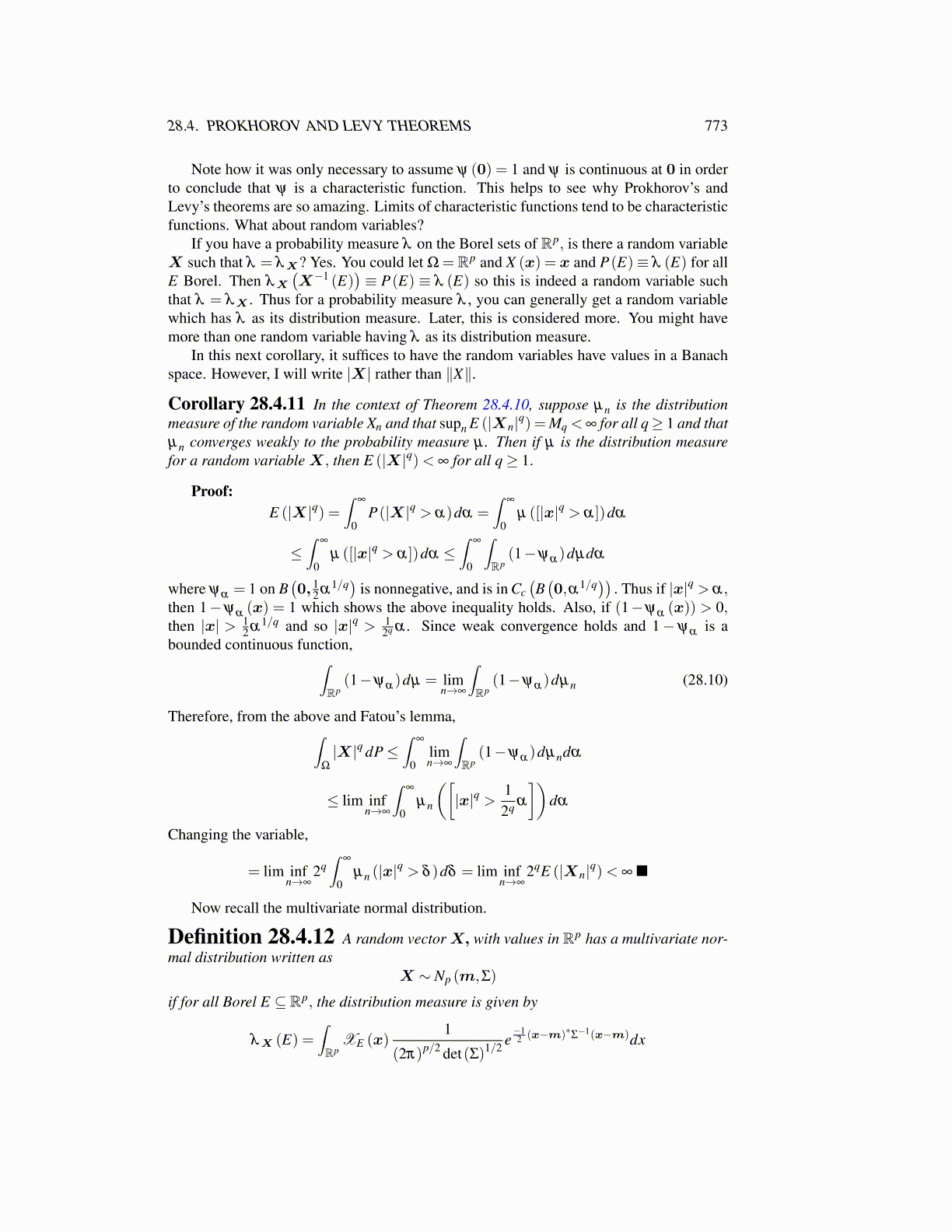
28.4. PROKHOROV AND LEVY THEOREMS 773
Note how it was only necessary to assume ψ (0) = 1 and ψ is continuous at 0 in orderto conclude that ψ is a characteristic function. This helps to see why Prokhorov’s andLevy’s theorems are so amazing. Limits of characteristic functions tend to be characteristicfunctions. What about random variables?
If you have a probability measure λ on the Borel sets of Rp, is there a random variableX such that λ = λX? Yes. You could let Ω =Rp and X (x) = x and P(E)≡ λ (E) for allE Borel. Then λX
(X−1 (E)
)≡ P(E) ≡ λ (E) so this is indeed a random variable such
that λ = λX . Thus for a probability measure λ , you can generally get a random variablewhich has λ as its distribution measure. Later, this is considered more. You might havemore than one random variable having λ as its distribution measure.
In this next corollary, it suffices to have the random variables have values in a Banachspace. However, I will write |X| rather than ∥X∥.
Corollary 28.4.11 In the context of Theorem 28.4.10, suppose µn is the distributionmeasure of the random variable Xn and that supn E (|Xn|q) =Mq <∞ for all q≥ 1 and thatµn converges weakly to the probability measure µ . Then if µ is the distribution measurefor a random variableX, then E (|X|q)< ∞ for all q≥ 1.
Proof:E (|X|q) =
∫∞
0P(|X|q > α)dα =
∫∞
0µ ([|x|q > α])dα
≤∫
∞
0µ ([|x|q > α])dα ≤
∫∞
0
∫Rp
(1−ψα)dµdα
where ψα = 1 on B(0, 1
2 α1/q)
is nonnegative, and is in Cc(B(0,α1/q
)). Thus if |x|q > α,
then 1−ψα (x) = 1 which shows the above inequality holds. Also, if (1−ψα (x)) > 0,then |x| > 1
2 α1/q and so |x|q > 12q α . Since weak convergence holds and 1−ψα is a
bounded continuous function,∫Rp
(1−ψα)dµ = limn→∞
∫Rp
(1−ψα)dµn (28.10)
Therefore, from the above and Fatou’s lemma,∫Ω
|X|q dP≤∫
∞
0limn→∞
∫Rp
(1−ψα)dµndα
≤ lim infn→∞
∫∞
0µn
([|x|q > 1
2q α
])dα
Changing the variable,
= lim infn→∞
2q∫
∞
0µn (|x|
q > δ )dδ = lim infn→∞
2qE (|Xn|q)< ∞ ■
Now recall the multivariate normal distribution.
Definition 28.4.12 A random vectorX, with values in Rp has a multivariate nor-mal distribution written as
X ∼ Np (m,Σ)
if for all Borel E ⊆ Rp, the distribution measure is given by
λX (E) =∫Rp
XE (x)1
(2π)p/2 det(Σ)1/2 e−12 (x−m)∗Σ−1(x−m)dx